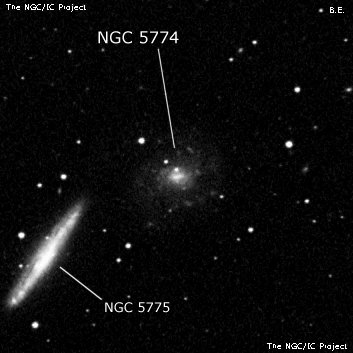
George Johnstone Stoney, LdR's assistant, discovered NGC 5774 on 26 Apr 1851. While observing NGC 5775 he noted " NGC 5775] is a long ray with another nebula [NGC 5774] about 3' preceding and a little north." Heinrich d'Arrest measured an accurate position on two nights.
400/500mm - 17.5" (4/13/91): fairly faint, moderately large, round, fairly low surface brightness, gradually brighter but no well-defined core. A mag 14 star is off the NE edge 1.4' from center. Forms a pair with NGC 5775 4.5' SE.
600/800mm - 24" (7/14/15): at 375x; moderately to fairly bright, fairly large, slightly elongated NW-SE, 2.0'x1.5', slightly brighter middle, gradually increases towards the center. Either contains a faint stellar nucleus or a faint star is superimposed near the center. A mag 14 star is just off the northeast side, 1.4' from the center. Forms a trio with NGC 5775 4.4' SE and IC 1070 6.3' SSE.
900/1200mm - 48" (4/19/17): Interesting face-on SBc spiral at 488x. Contains a fairly bright, small oval core with a weak E-W bar. A spiral arm is attached on the south side of the core and curls at least 90° counterclockwise towards the south and west, ending about 40" WNW of center. A second arm is on the north side of the core but it was more difficult to distinguish as it wraps east tight to the core. Finally, a fairly long, detached spiral arm of low surface brightness is on the southwest side of the halo, extending linearly WNW-ESE. On the SDSS, this "arm" consists of a number of adjacent blue HII knots and angles towards companion NGC 5775. Two stars are superimposed north of center, one just 12" N and a mag 16 star 30" NE.
Notes by Steve Gottlieb